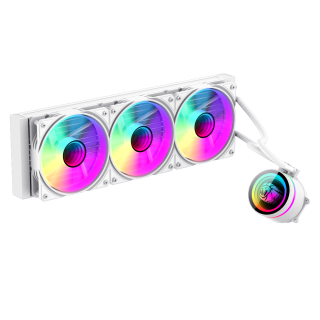Selecting an All-in-One (AIO) CPU cooler that seamlessly integrates with your motherboard is crucial for optimal performance and system stability. Whether you’re building a new PC or upgrading your cooling solution, understanding compatibility factors ensures a hassle-free installation and efficient heat dissipation. Below is a comprehensive guide to navigate this process, supported by technical insights and practical examples.

The first and most critical step is verifying that the AIO cooler supports your motherboard’s CPU socket. Different manufacturers (Intel and AMD) use distinct socket types, and even within the same brand, newer generations may require specific mounting brackets.
Intel Sockets: Common types include LGA 1700 (12th/13th Gen Core), LGA 1200 (10th/11th Gen), and LGA 115x (older generations).
AMD Sockets: Current 主流 choices are AM5 (Ryzen 7000 series) and AM4 (Ryzen 5000 series).
Check the Fine Print: Most AIO coolers explicitly list supported sockets in their product descriptions. For example, the CORSAIR iCUE H150i Elite Capellix supports both LGA 1700 and AM5, while older models like the NZXT Kraken X63 may require a bracket upgrade kit for newer sockets .
Action Step: Visit the manufacturer’s website or check the product manual to confirm socket compatibility. Some brands, like ASUS and Gigabyte, also provide compatibility lists for their motherboards.
Your motherboard’s size (ATX, Micro-ATX, Mini-ITX) and layout influence where you can install the AIO cooler’s radiator.
ATX/Micro-ATX: Typically offer more flexibility, with support for 240mm or 360mm radiators on the top or front of the case.
Mini-ITX: Space-constrained builds may require a 120mm or 240mm radiator, often mounted on the front or rear.
Clearance Issues: Ensure the radiator doesn’t block RAM slots, PCIe ports, or the motherboard’s VRM heatsinks. For example, the Thermalright Aqua Elite 120 V3’s compact design suits Mini-ITX builds, while larger radiators like the ARCTIC Liquid Freezer II 420 demand spacious cases .
Pro Tip: Measure your case’s available space and use tools like PCPartPicker to simulate radiator placement.
AIO coolers require power for the pump and fans, which must be compatible with your motherboard’s headers.
Pump Power: Most AIOs use a 3-pin or 4-pin (PWM) connector. Ensure your motherboard has a dedicated CPU_OPT or AIO_PUMP header for optimal control.
Fan Headers: If the cooler includes multiple fans (e.g., a 360mm radiator with three fans), check if your motherboard has enough PWM headers. If not, use a fan hub or splitter.
Example: The ASUS TUF GAMING X870-PLUS WIFI features a dedicated AIO_PUMP header and multiple PWM fan headers, simplifying connections for high-end coolers .
Warning: Avoid daisy-chaining too many fans, as this may overload the motherboard’s power delivery.
For enthusiasts, RGB lighting integration is a key consideration. Ensure the AIO cooler’s lighting system works with your motherboard’s RGB software.
Standardized Protocols:
5V ARGB: Uses a 3-pin connector (e.g., ASUS Aura Sync, Gigabyte RGB Fusion).
12V RGB: Uses a 4-pin connector (e.g., MSI Mystic Light).
Software Control: Brands like CORSAIR (iCUE) and NZXT (CAM) offer proprietary software, but some AIOs, like the Lian Li Galahad II, support universal ARGB standards .
Example: The CORSAIR iCUE H100i LCD can sync with ASUS Aura Sync via the iCUE Link hub, creating a cohesive lighting setup .
The AIO cooler’s thermal capacity must match your CPU’s heat output, especially during overclocking.
TDP Ratings: The cooler’s TDP should exceed your CPU’s thermal design power. For example, a ICEBURG 360 DIGITAL BK (170W TDP) requires a 360mm AIO like the ICEBURG 360 DIGITAL BK, which handles up to 350W .
Fan and Pump Efficiency: Higher-end coolers often use premium fans (e.g., Noctua IndustrialPPC) and advanced pump designs for better performance.
Tip: Use benchmarks from sites like Tom’s Hardware to compare cooling performance under load.
Evaluate the AIO cooler’s installation process and included components.
Mounting Kits: Ensure the cooler includes all necessary brackets, screws, and backplates. For example, the Cooler Master MasterLiquid ML240L includes brackets for LGA 1700 and AM5 .
Ease of Installation: Some AIOs, like the ICEBURG 360 DIGITAL, feature tool-free mounting, while others may require removing the motherboard to install the backplate.
User Feedback: Check reviews for common complaints, such as difficult bracket alignment or inadequate thermal paste.
Consider how the AIO cooler will adapt to future upgrades.
Socket Support: Opt for coolers that include brackets for multiple sockets
Case Compatibility: If you plan to upgrade your case, ensure the AIO’s radiator size remains compatible.
Selecting the right AIO CPU cooler for your motherboard involves a mix of technical checks and practical considerations. Prioritize socket compatibility, physical dimensions, and power requirements, then refine your choice based on RGB preferences and cooling performance. Always verify specifications with the manufacturer and leverage user reviews to avoid common pitfalls. With these steps, you’ll ensure a seamless integration that maximizes both performance and aesthetics.

GameMax ICEBURG 360 Infinity Liquid CPU Cooler 360mm Addressable RGB PWM Pump Fans 300W TDP AIO Water Cooler for Intel LGA1851/1700/1200/115X AMD AM5/AM4
• Addressable RGB Sync: The Addressable RGB lighting on the fans and pump can sync with the motherboard via a 5V 3pin interface, providing even and rich illumination
• TRIPLE ARGB FANS - 3x 120mm ARGB PWM fans provide excellent pressure and airflow while generating very little noise.(Note: The PWM mode must be set in BOIS before liquid cooler operation, otherwise the fan will run at a fixed speed of full speed or low speed)
• Better Cooling Performance: With a more efficient cold plate, spraying copper bottom, proprietary pump, and fans optimized for static pressure to make sure excellent heat transfer from CPU
• Industrial Grade Seal High Industrial Grade EPDM material to strengthen the seal for improved longevity and Anti-Leaking
• ROTATABLE BLOCKHEAD - Features a 270° rotatable water block with the GameMax logo in ARGB as well as Addressable RGB fans for multiple lighting effects
• Wide Compatibility: Intel LGA 1851/1700/1200/2066/2011-3/2011/1156/1155/1151/1150, AMD AM5/AM4/AM3+/AM3/AM2+/FM2+/FM2
• (Note: No AMD backplate in the package, The AMD must be installed with the original bracket of the motherboard